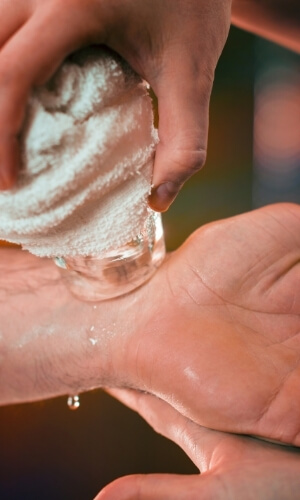Perhaps a little piece of knowledge that I’ve taken for granted in the past – whether we should be icing our injuries or applying heat.
It seems like a really simple decision to make, but I’m constantly being asked which is the right one to use.
What’s recently been brought to my attention is that some people believe that one is better than the other for treating all injuries. There is no truth to this myth.
Ice packs and heat packs work in different ways to effect pain, inflammation, muscle spasm and injury repair. Here we will attempt to remove the doubt surrounding this long standing debate.
How Ice Packs Work
The application of cold for injury rehabilitation is called cryotherapy.
This application may come in the form of ice packs, cold compress, ice massage or ice baths (cold emersion).
The intention of this type of therapy is to reduce the core temperature of the underlying tissues to achieve a physiological effect.
By reducing the temperature of the skin or underlying tissues we start to get constriction of the blood vessels which then reduces blood flow. From here we will naturally reduce the tissue metabolism which reduces the sensitivity of the nerves (i.e. you will feel less pain) and slows the process of inflammation.
What we also see is that using cold packs on a joint will reduce the joints core temperature which can inhibit the enzymes involved in cartilage wear. This means less degenerative cartilage damage in the joints just by using ice packs!
Keep in mind that ice packs don’t need to be super cold. When you expose the skin to very cold temperatures the skin can succumb to an ice burn. This will result in skin damage which can take weeks to recover from. Avoid this by placing a thin towel or a layer of clothing between the ice pack and your skin.
Remember the hunting reflex – our tissues are not designed to withstand this type of cold for long periods of time, so when we leave an icepack on for more than 10 minutes our blood vessels will actually dilate to increase blood flow and warm the area back to normal temperature. For this reason you should avoid icing the area for more than 10 minutes.
How Heat Packs Work
Heat packs works in the opposite way to ice packs.
Heat application is designed to increase the core temperature of the underlying tissue to create vasodilation. This response of vasodilation results in an increase in blood flow to the area.
By increasing blood flow we increase the metabolic rate of the tissue which improves tissue extensibility. This is why so many people say that heat feels good. It will reduce spasm in the muscle and make it feel more relaxed.
Heat will also increase oxygen uptake which will accelerate tissue healing.
However there is a down side. Increasing blood flow and oxygen to accelerate tissue activity sounds great and in many cases it is. But unfortunately we can’t be selective about the other processes heat accelerates.
Heat therefore has the potential to increase the activity of destructive enzymes and can accelerate inflammation of an injured tissue.
We need to be selective about when we use heat packs to optimise healing and reduce recovery times.
Which One To Use?
Now that we understand how these work, let’s discuss which one to use for particular phases of injury.
Acute injuries will work in three phases:
- Inflammatory phase: this is where a tissue gets damaged and an immediate inflammatory response is initiated to start the healing process. This is characterized by local swelling, warmth and pain. In this phase of the injury you should use ice packs. The ice packs will not completely stop the inflammation but will slow it and prevent excessive amounts. This will result in less swelling and more comfort at the site of the injury.
- Proliferation phase: New scar tissue is starting to form to repair the damaged tissue. In this phase you can start using heat to help speed up the healing process.
- Remodeling phase: This is the final phase of the healing process. Scar tissue will begin to break down and will be replaced with healthy tissue. Heat can also be used at this phase of the recovery.
Let’s look at these phases in the context of an ankle sprain.
When you sprain your ankle you will likely have some swelling at the outer part of the ankle. This build up of swelling is part of the inflammatory phase and you should place an ice pack on for 10 minutes every hour.
In addition to this you may want to also elevate the leg and apply a compression bandage (the usual RICE approach). Depending on the severity of the sprain, this process will last for 7-10 days.
You should work with your physiotherapist at this point to protect the injury, improve tissue remodeling and ensure optimal healing of the damaged ligament.
During this phase you may find that walking causes a mild irritation of your symptoms – in these instances you should apply an ice pack after the walk to settle any new inflammation.
Heat packs can be used in these situations, but only after the inflammatory phase has stopped.
In a separate incident, if you have a neck injury that feels stiff when you wake up in the morning or painful after long hours in front of the computer (tech neck) you’re more likely to benefit from a heat pack.
These injuries will occur without any traumatic event and are commonly caused by poor postures and repeated overload.
Because the issue here is causing muscle spasm (as opposed to inflammation) the heat pack will be beneficial to improve blood flow and help settle the muscle, creating a more comfortable and relaxed feeling in the neck.
It’s safe to use heat packs in these instances because there is no inflammation, therefore we won’t be increasing the swelling or increasing the activity of destructive enzymes.
What Does The Evidence Say?
The evidence for these therapies and their mechanisms of action are strong, however, the effectiveness of these treatments is debated.
The reality is that the effectiveness will vary depending on the condition and how the therapy is applied.
The reason it’s so widely used is that they have relatively good effect with minimal cost and very low risk of causing more damage.
Although it seems simple, many people often get these approaches mistaken and use the wrong approach.
Maximise the benefits of these treatments by only applying them for short periods (about 10 minutes per hour) and avoiding extreme cold or heat to prevent burns.
Book an appointment with our physio for assistance with your injury.
One-on-One Physiotherapy Care - Complete Attention - You Deserve It !
Contact Us today to find out how we can help you.







